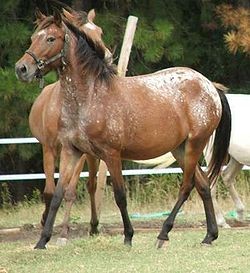The original Spanish Jennet was a type of horse more than a
distinct breed, and became extinct. However there have been effort to recreate
a colored variety of gaited horse that resembles the historical Jennet or
"Spanish Jennet."
The Jennet was a smooth-gaited type of horse popular in the
Middle Ages, known for their presence, style and smooth ride. They were often
ridden by European nobility. Some early Jennets sported pinto or leopard
patterns.
Most of the Medieval horses bred during the 1500's in Spain
and elsewhere were not "breeds" in the modern sense of the word. The
Jennet from Spain became more uniform in type due to a single geographical
region producing them as well as generations of selective breeding during the
Middle Ages to produce a smooth riding horse that was suitable for the riding
style a la jineta. It would never have occurred to a Spaniard of the sixteenth
century to distinguish "breeds" on the basis of registration papers
as we do today. In that time in history the breeders and fanciers of these
particular horses would have called the horse by the names of the regions or
family that bred them. For Example, Guzman, Asturcon.
As assorted Iberian horses came to the Americas and the
Spaniards of the New World preserved the riding style as well as the horses
that suited this style, the horses became known simply as the "Spanish
Jennet." Today, some of the descendants of those early Spanish Jennets are
known as Paso Finos and Peruvian Pasos. This is the horse that is mentioned by
name as the ancestor of the Paso Fino and Peruvian Paso Horse (The Spanish Jennet
gave its even temperament and smooth ambling gait) breeds as well as many other
modern gaited breeds. The Spanish Mustang is another probable descendant.
The Paso Fino and Peruvian Paso have predominantly bred away
from coat colors that include spotting patterns. The notable exception being
the pinto Paso Fino. However, historians agree that the early Colonial Spanish
era horses did come in more exotic patterns.
The Spanish Jennet Horse is a new breed of Jennet type is
being created through the efforts of the Spanish Jennet Horse Society. The
Registry requires that horse for the Pintado division be of full Paso Fino
heritage and the Atigrado division must be at least of 50% Paso blood.
Outcrosses are allowed in the first generation to obtain the
LP for the Registered Atigrado Spanish Jennet and must result in a minimum of
50% purebred Paso Fino or Peruvian Paso horse. Only one outcross is allowed (to
obtain Lp or Appaloosa pattern). All 50% crosses will provide video proof of
gait before registration of their offspring.
The Spanish Jennet Horse is a well-proportioned animal of
moderate height and build. Extremes in muscling or bone are considered faults.
The optimum appearance is that of refinement with a deep chest, well sprung
ribs and a strong, medium length back with broad, well muscled loins.
The Paso gait of the Spanish Jennet Horse (like that of all
Paso horses) is completely natural and frequently exhibited at birth. Gait may
be refined through training, but no artificial training equipment or special
shoeing is used.
It is a four-beat, lateral gait with each foot contacting
the ground independently in a regular sequence at precise intervals creating a
rapid, unbroken rhythm. The musical cadence produces the sound:
taca-taca-taca-taca. Executed perfectly, the continuous rhythm is even in both
cadence and impact. Footfall is in the same sequence as a natural equine walk:
left rear, left fore, right rear, right fore. Propulsion is from the
hindquarters and the horse's movement is absorbed in its back and loins,
resulting in unequaled smoothness and comfort for the rider.
The Corto or Llano is a relaxed, ground covering gait which
is ideal for pleasure, and trail riding. About the speed of a jog trot, rack or
running walk. Most SJ horses prefer this gait to the walk.
The Largo is the speed form of the gait, with speeds
equivalent to that of a canter or in some cases a gallop. Flat walk or
Collected walk like all equines.
In all speeds of the gait, the rider should appear virtually
motionless in the saddle, and there should be no perceptible up and down motion
of the horse's croup. The Spanish Jennet can also perform the canter and
gallop.
The breed comes in every equine coat color within the horse
world, except gray. Gray horses are excluded from registration to eliminate the
loss of pattern through the graying process.
There are two divisions of color patterns, the Pintado, a
pinto pattern that occurs in Tobiano, Overo, and Sabino, and the Atigrado, a
leopard pattern similar to that of the Appaloosa, that displays characteristics
of the "Lp" gene including coat pattern, mottled skin, white sclera,
and striped hooves. The pinto and leopard (Appaloosa) patterning of the Spanish
Jennet Horse is a result of a variety of genetic processes that may result in
heterozygous, homozygous or no pattern inheritance. Therefore, there are
patterned and solid-colored progeny in both the Pintado and Atigrado portions
of the registry.
The Spanish Jennet Horse is a naturally agile and athletic
horse, capable of many disciplines. They have a natural cow sense, inherited
from the use of the ancestors of the breed on cattle haciendas and ranches for
many decades.
The natural tendency for the horse to lighten the forehand
and engage the hindquarters makes it ideal for versatility and cow penning. The
smooth gait makes the Spanish Jennet Horse a great choice for trail riding and
endurance riding competitions, as well as many other disciplines.
